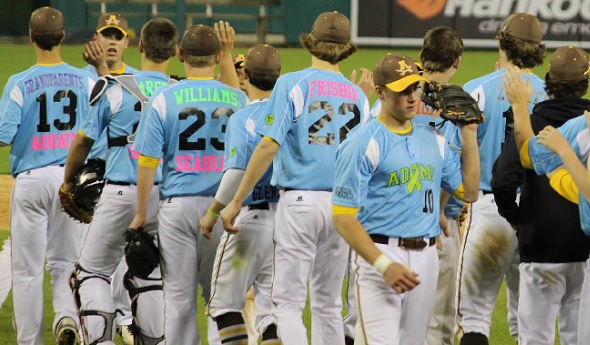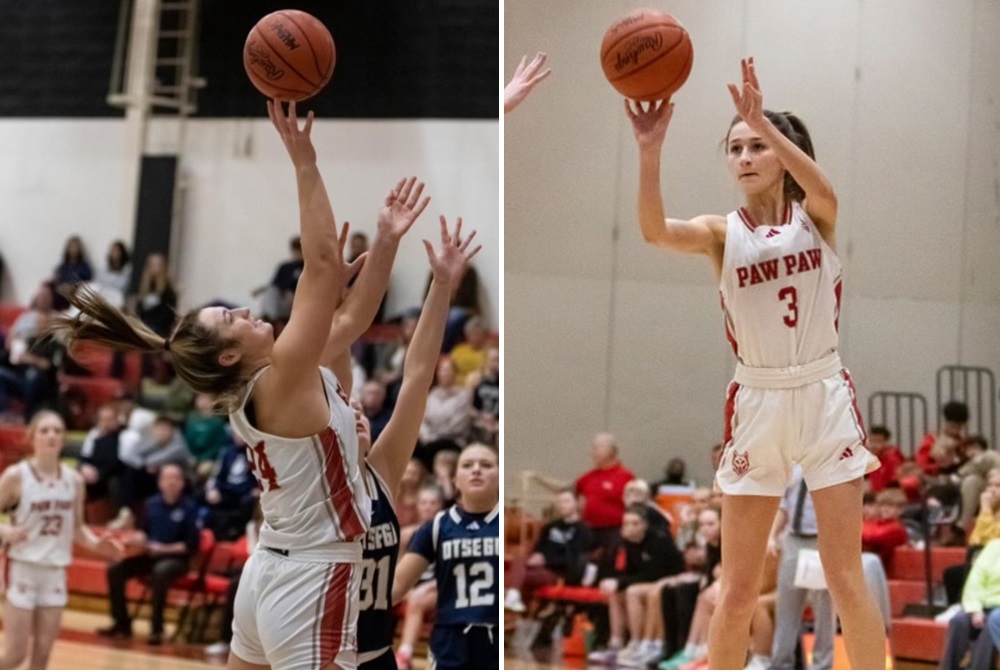
Paying Tribute with Diamond Donation
May 14, 2014
By Geoff Kimmerly
Second Half editor
Rochester Adams and Bloomfield Hills Cranbrook-Kingswood baseball players and coaches both had loved ones on their minds when they took the field at Comerica Park earlier this month.
And they paid tribute to those loved ones over their hearts and across the backs of their jerseys.
 Together, the teams raised more than $3,500 for the Coaches vs. Cancer research initiative.
Together, the teams raised more than $3,500 for the Coaches vs. Cancer research initiative.
Instead of its usual brown and yellow, Adams wore jerseys of light blue with a green ribbon as the middle “A” in its name across the front in honor of those suffering with lymphoma, including 2011 graduate and former standout Matt Williams.
 Cranbrook-Kingswood wore dark blue jerseys with a pink ribbon as the “A” in Cranbrook and with lime green writing on the back as the Cranes remembered longtime coach Jack Sanders, who died in 2012 after also battling lymphoma.
Cranbrook-Kingswood wore dark blue jerseys with a pink ribbon as the “A” in Cranbrook and with lime green writing on the back as the Cranes remembered longtime coach Jack Sanders, who died in 2012 after also battling lymphoma.
Sanders’ was among names adorning the backs of jerseys, along with other cancer victims the players and coaches knew.
Adams won the May 1 game, 18-3. Click to read more from the Oakland Press’ Keith Dunlap, who leading up to the game detailed both Williams’ fight and Sanders’ longtime contributions.
Net finder
Lake Fenton’s Jordan Newman will finish her high school soccer career later this spring as the top goal-scorer in MHSAA girls soccer history.
The Blue Devils’ senior forward broke the career record on April 28, scoring her 169th goal against Perry to pass the mark set by Newaygo’s Jaleen Dingledine from 2004-07. Newman also is a four-year varsity player.
Click to read more on her record run from the Flint Journal's Eric Woodyard.
5 K, 1 IP
The MHSAA doesn't keep a record for most strikeouts in an inning. But if it did, there’s a great chance Brighton’s Garrett Russell would top the list.
Against Ann Arbor Pioneer on April 5, Russell struck out five batters in an inning.
Yes, five.
Here’s how:
Russell struck out the first two batters of the inning swinging, leaving one out to get. He then struck out that third batter as well, but that batter reached first base because the third strike turned into a wild pitch.
The fourth batter of the inning was the only one to not strike out – he walked, putting runners on first and second base with two outs. Those runners advanced to second and third base, respectively, on a wild pitch thrown to the fifth batter of the inning.
That fifth batter then struck out swinging (which made it four strikeouts in the inning), but that third strike turned into a passed ball – and that batter ended up on first base, loading them for the sixth hitter of the inning.
But Russell found enough for one more K, striking out that sixth hitter swinging on a 2-2 pitch.
His line for the inning: 0 hits, 0 runs, 1 bases on balls, 5 strikeouts.
Brighton went on to sweep the doubleheader 12-4 and 11-1.
Family ties
Basketball clearly runs in a pair of families who have come through Corunna High School.
This winter, brothers M.J. and Mikhail Myles both scored their 1,000th career points – M.J., a senior, on Jan. 3 and Mikhail, a junior, in the team’s District Semifinal on March 5.
On Feb. 18, senior Payton Birchmeier became the fifth player in girls program history to score her 1,000th point – despite scoring only four points as a freshman before suffering a season-ending knee injury in her first high school game. She became the first Corunna girl to score 1,000 since her sister Megan finished accomplishing the feat in 2010.
Payton Birchmeier went on to play her final three seasons also on varsity, and M.J. Myles also was a four-year varsity player. Mykhail Myles has played three on varsity with next season still to play. The Myles' stepsister Klarissa Bell this winter finished an outstanding career at Michigan State University and won the Miss Basketball Award as a senior at East Lansing High School in 2010, and stepbrother Devlin Bell also was a Trojans standout.
PHOTOS: (Top) Rochester Adams players congratulate each other during their May 1 game at Comerica Park. (Middle) The Adams' first baseman and a Cranbrook-Kingswood base runner await the next pitch. (Photos courtesy of Rochester Adams baseball.)

Paw Paw Hoops Heroes Closing in on Milestones, Rewriting School Record Book
By
Pam Shebest
Special for MHSAA.com
November 19, 2024
PAW PAW — With a basketball pedigree that goes back a generation, Paw Paw’s Grace Mitchell is one of two seniors closing in on personal and school records.
 Mitchell is just 164 points shy of joining the 1,000-point club.
Mitchell is just 164 points shy of joining the 1,000-point club.
“After my sophomore year I was over 500 (points), so I knew I could get another 500 my last two years,” said Mitchell, adding that the milestone is one of her long-time goals.
And she’s not the only one pursuing it.
Teammate AJ Rickli, a 6-foot-2 center/power forward, needs just 110 points to hit the 1,000-point mark.
Rickli stacked up her points in just over two seasons, after moving up from junior varsity near the end of her freshman year.
Scoring isn’t the only strength the players bring to the team.
Mitchell, a 5-10 guard, needs just four 3-pointers to break the school record of 156, something second-year head coach Dan Thornton said could happen when the Red Wolves open the season Dec. 3 by hosting Mattawan.
She holds the school’s season record for treys with 72 and swished eight in one game, tying another school record.
“I shoot a lot,” Mitchell said. “I’ve always like shooting the farther shots since I was little, but sophomore year I really got good at my 3-point shots.”
She is not a one-dimensional player, either, with 126 assists and 150 steals heading into her fourth varsity season.
That’s where the two seniors complement each other.
“She’s a guard; I’m a post,” Rickli said. “Where I slack, she picks up. Where she slacks, I pick up. I get her rebounds.”
Thornton said both players could reach other school milestones this season.
 “Grace potentially could be closing in on marks for steals, assists, on top of her shooting percentage from the free throw line and 3-point line,” he said, adding that Rickli could break the records for rebounds and blocks.
“Grace potentially could be closing in on marks for steals, assists, on top of her shooting percentage from the free throw line and 3-point line,” he said, adding that Rickli could break the records for rebounds and blocks.
The coach is not surprised he has two players heading into 1,000-point territory.
“Last year we averaged about 75 points per game, and we had four different players average about double figures,” he said. “There were a lot of games where we’d get three, four and some games six people in double figures.
“It also meant everyone was scoring between 10 and 13 or 14 points per game. It made it very challenging on opposing defenses because if they focus too much on one, the other four would get very favorable matchups.”
Just two days into practice, Thornton said he plans to fill out his roster after Wednesday’s practice, laughing, “(Grace and AJ) both have a chance to make varsity.”
The Red Wolves graduated five seniors in the spring, two of them starters, from last year’s 22-3 team that advanced to a Division 2 District Final.
“It’s going to take a lot of determination and drive from everybody on the team (to move past Districts),” Rickli said. “Everybody has to contribute. Everybody has to want it the same, and we’ve got to have a team goal. And we will.”
Thornton will rely on Rickli and Mitchell for leadership, especially for those brought up from the junior varsity team.
“The two girls bring veteran leadership,” Thornton said. “They’ve both been through playing on varsity, playing in big games for a number of years.
“Both have had huge success over the years. I expect them to help nurture along younger players, guide them through our goals throughout the season.”
Rickli said the most important thing for new players is to let them know their roles.
“I’ll help the posts in their position. Grace will help the guards in their position and give them confidence,” Rickli said. “We’ll help them in practice. We’re not going to take it easy on them, because that won’t help them at all. We’ll push them in practice to get them used to varsity play.”
'Batman and Superman'
Rickli and Mitchell have been best friends and on the same hoops teams since second grade.
“We work really good together because we’re each other’s best friend, and we’ve played together forever,” Mitchell said. “We know what each other wants.
"I know how to get (the ball) in to her, and she knows when to kick it out to me. When I miss my shot, she gets my rebound and puts it back up, so it works out pretty good.”
Rickli, whose formal first name is Arin Jolyn, also plays volleyball and competes in the shot put and discus, but prefers basketball.
“Basketball just comes to me easier than the other sports,” she said. “I like the contact sports.”
Mitchell, who has committed to Alma College for golf and basketball, is keeping up her family hoops tradition.
“She comes from a very, very heavy basketball family,” said Thornton, who has been involved in coaching for 35 years and needs just 12 more varsity wins for 400. “Her father (Rick Mitchell) is legendary in basketball throughout most of Southwest Michigan. Her Uncle Gary (Mitchell) was a longtime coach (at Paw Paw), the same as her father, who is in the Paw Paw Hall of Fame.
“To have that kind of constant exposure at a young age to basketball from her family, be it her siblings or uncle or dad, probably helped Grace.”
Both girls are unselfish and supportive of their teammates, he said, adding, “They do a good job helping each other be successful. They’re very much Batman and Superman, you could say, because one of them excels in a certain area of the game and the other excels in another area.
“The fact that the players, the team, aren’t selfish really speaks to the parenting with these players, how they’ve been raised and how they are willing to give up a good shot for themselves to give someone else a great shot.”
 Pam Shebest served as a sportswriter at the Kalamazoo Gazette from 1985-2009 after 11 years part-time with the Gazette while teaching French and English at White Pigeon High School. She can be reached at [email protected] with story ideas for Calhoun, Kalamazoo and Van Buren counties.
Pam Shebest served as a sportswriter at the Kalamazoo Gazette from 1985-2009 after 11 years part-time with the Gazette while teaching French and English at White Pigeon High School. She can be reached at [email protected] with story ideas for Calhoun, Kalamazoo and Van Buren counties.
PHOTOS (Top) At left, Paw Paw senior AJ Rickli gets a shot up against Otsego last season; at right, senior Grace Mitchell releases a jumper. (Middle) From left: Paw Paw coach Dan Thornton, Rickli and Mitchell. (Action photos by René Rodriguez; head shots by Pam Shebest.)

